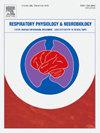妊娠晚期用力性呼吸困难的神经生理机制:一个案例研究
IF 1.6
4区 医学
Q3 PHYSIOLOGY
引用次数: 0
摘要
妊娠晚期劳力性呼吸困难的神经生理机制尚不完全清楚。这篇简短的病例报告描述了一名健康成年女性在三个时间点进行标准化心肺运动试验(CPET)时的神经生理和感觉反应:a)孕前3个月,b)怀孕35周(妊娠晚期[T3]), c)产后1年。在休息和运动时,完成神经生理、气体交换和感觉参数的详细测量。与孕前和产后相比,在整个运动过程中,T3的通气需求、膈肌电激活(EMGdi,吸气神经驱动指数)和食管压力波动都更高。此外,在给定的工作速率下,与孕前和产后相比,T3期的呼吸困难更大,并且与运动过程中EMGdi的升高密切相关。在T3运动高峰时,与孕前和产后相比,呼吸困难/通气和EMGdi/通气比更大。与孕前相比,产后EMGdi和呼吸困难更大,接近运动耐量的极限,继发于早期呼吸代偿介导的通气增加。在本病例中,在标准化临床CPET中,妊娠晚期与呼吸困难评分明显升高和运动能力降低相关。在次极大强度下,呼吸困难加重反映了妊娠引起的通气需求、吸气神经驱动和呼吸肌用力增加的意识。在耐受极限下,呼吸困难加剧和吸气神经驱动反映了通气需求增加和潮汐容量扩张的机械约束的复杂组合。与孕前相比,产后1年的残余活动相关呼吸困难似乎反映了身体状况的改善。本文章由计算机程序翻译,如有差异,请以英文原文为准。
Neurophysiological mechanisms of exertional dyspnea in advanced pregnancy: A case study
The neurophysiological mechanisms of exertional dyspnea in advanced pregnancy remain incompletely understood. This short case report describes the neurophysiological and sensory responses during standardized cardiopulmonary exercise testing (CPET) in one healthy adult female at three timepoints: a) 3 months pre-pregnancy, b) 35 weeks pregnant (third trimester [T3]), and, c) 1 year post-partum. At rest and during exercise, detailed measurements of neurophysiological, gas-exchange and sensory parameters were completed. Compared to both pre-pregnancy and post-partum, ventilatory requirements, electrical activation of the diaphragm (EMGdi, index of inspiratory neural drive) and esophageal pressure swings were higher in T3 throughout exercise. Moreover, at a given work rate, perceived dyspnea was greater in T3 compared with pre-pregnancy and post-partum and increased in close association with heightened EMGdi throughout exercise. At peak exercise in T3, dyspnea/ventilation and EMGdi/ventilation ratios were greater, compared with pre-pregnancy and post-partum. Compared with pre-pregnancy, EMGdi and perceived dyspnea were greater post-partum near the limits of exercise tolerance, secondary to earlier onset of respiratory compensation-mediated increases in ventilation. In the current case, advanced pregnancy was associated with markedly elevated ratings of dyspnea and lower exercise capacity during a standardized clinical CPET. At submaximal intensities, the heightened dyspnea reflected the awareness of pregnancy-induced increases in ventilatory requirements, inspiratory neural drive, and respiratory muscle effort. At the limits of tolerance, heightened dyspnea and inspiratory neural drive reflected a complex combination of increase ventilatory requirements and mechanical constraints on tidal volume expansion. Compared with pre-pregnancy, residual activity-related dyspnea 1-year post-partum appears to reflect physical deconditioning.
求助全文
通过发布文献求助,成功后即可免费获取论文全文。
去求助
来源期刊
CiteScore
4.80
自引率
8.70%
发文量
104
审稿时长
54 days
期刊介绍:
Respiratory Physiology & Neurobiology (RESPNB) publishes original articles and invited reviews concerning physiology and pathophysiology of respiration in its broadest sense.
Although a special focus is on topics in neurobiology, high quality papers in respiratory molecular and cellular biology are also welcome, as are high-quality papers in traditional areas, such as:
-Mechanics of breathing-
Gas exchange and acid-base balance-
Respiration at rest and exercise-
Respiration in unusual conditions, like high or low pressure or changes of temperature, low ambient oxygen-
Embryonic and adult respiration-
Comparative respiratory physiology.
Papers on clinical aspects, original methods, as well as theoretical papers are also considered as long as they foster the understanding of respiratory physiology and pathophysiology.

 求助内容:
求助内容: 应助结果提醒方式:
应助结果提醒方式:


